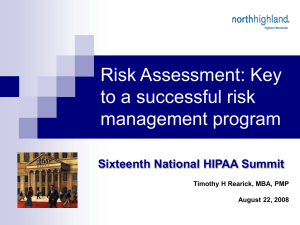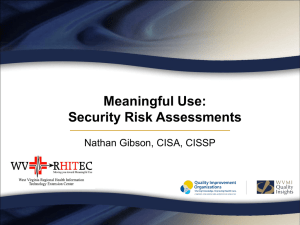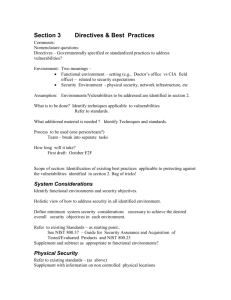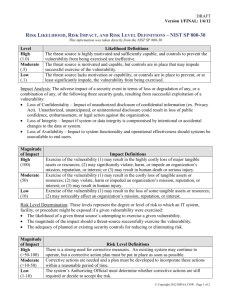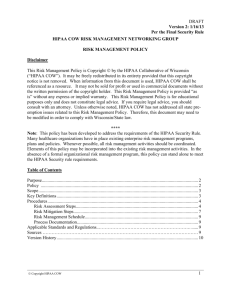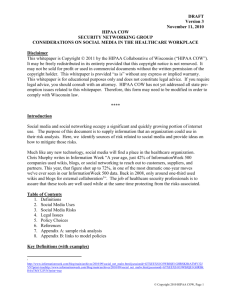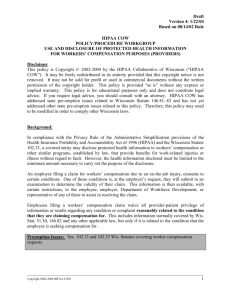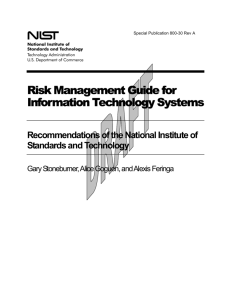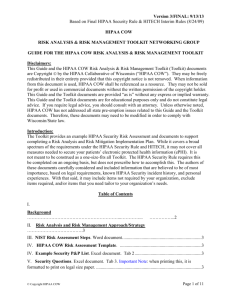NIST 800-30 Risk Assessment Steps
advertisement
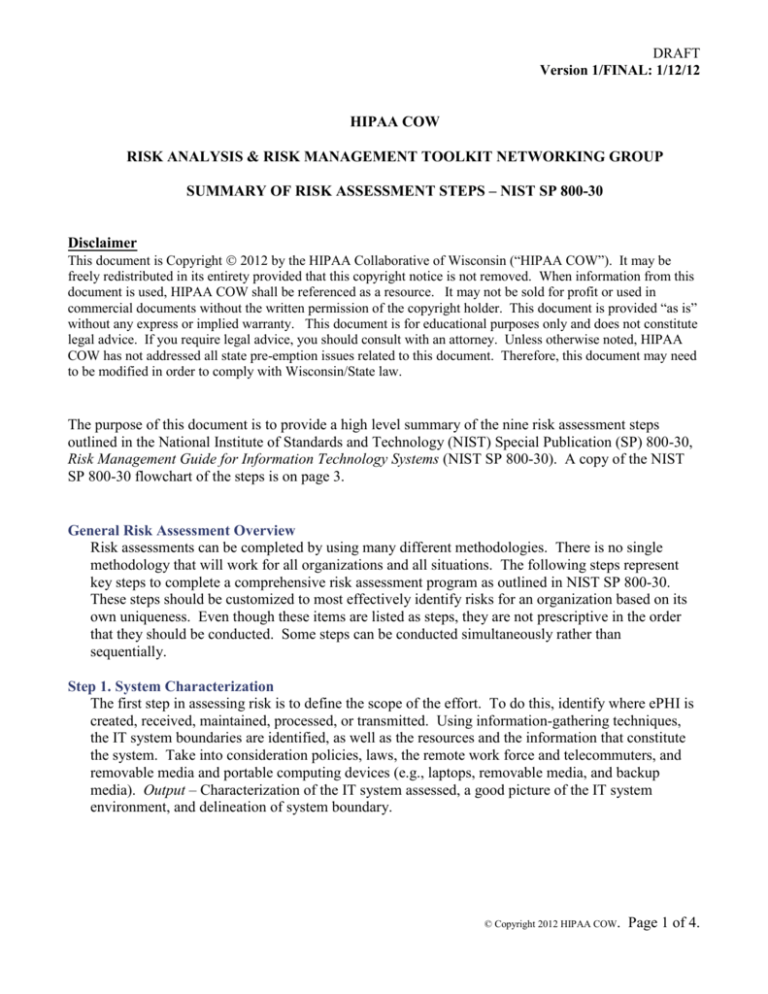
DRAFT Version 1/FINAL: 1/12/12 HIPAA COW RISK ANALYSIS & RISK MANAGEMENT TOOLKIT NETWORKING GROUP SUMMARY OF RISK ASSESSMENT STEPS – NIST SP 800-30 Disclaimer This document is Copyright 2012 by the HIPAA Collaborative of Wisconsin (“HIPAA COW”). It may be freely redistributed in its entirety provided that this copyright notice is not removed. When information from this document is used, HIPAA COW shall be referenced as a resource. It may not be sold for profit or used in commercial documents without the written permission of the copyright holder. This document is provided “as is” without any express or implied warranty. This document is for educational purposes only and does not constitute legal advice. If you require legal advice, you should consult with an attorney. Unless otherwise noted, HIPAA COW has not addressed all state pre-emption issues related to this document. Therefore, this document may need to be modified in order to comply with Wisconsin/State law. The purpose of this document is to provide a high level summary of the nine risk assessment steps outlined in the National Institute of Standards and Technology (NIST) Special Publication (SP) 800-30, Risk Management Guide for Information Technology Systems (NIST SP 800-30). A copy of the NIST SP 800-30 flowchart of the steps is on page 3. General Risk Assessment Overview Risk assessments can be completed by using many different methodologies. There is no single methodology that will work for all organizations and all situations. The following steps represent key steps to complete a comprehensive risk assessment program as outlined in NIST SP 800-30. These steps should be customized to most effectively identify risks for an organization based on its own uniqueness. Even though these items are listed as steps, they are not prescriptive in the order that they should be conducted. Some steps can be conducted simultaneously rather than sequentially. Step 1. System Characterization The first step in assessing risk is to define the scope of the effort. To do this, identify where ePHI is created, received, maintained, processed, or transmitted. Using information-gathering techniques, the IT system boundaries are identified, as well as the resources and the information that constitute the system. Take into consideration policies, laws, the remote work force and telecommuters, and removable media and portable computing devices (e.g., laptops, removable media, and backup media). Output – Characterization of the IT system assessed, a good picture of the IT system environment, and delineation of system boundary. © Copyright 2012 HIPAA COW. Page 1 of 4. DRAFT Version 1/FINAL: 1/12/12 Step 2. Threat Identification For this step, potential threats (the potential for threat-sources to successfully exercise a particular vulnerability) are identified and documented. A threat-source is any circumstance or event with the potential to cause harm to an IT system (intentional or unintentional). Common threat-sources can be natural, human, or environmental (refer to the Threat Source List for examples). Consider all potential threat-sources; review of historical incidents and data from intelligence agencies, the government, etc., help generate items to place on the list. Tailor the list based on the individual organization and its processing environment. Output – A threat statement containing a list of threatsources that could exploit system vulnerabilities. Step 3. Vulnerability Identification The goal of this step is to develop a list of technical and non-technical system vulnerabilities (flaws or weaknesses) that could be exploited or triggered by the potential threat-sources. Vulnerabilities can range from incomplete or conflicting policies that govern an organization’s computer usage to insufficient safeguards to protect facilities that house computer equipment to any number of software, hardware, or other deficiencies that comprise an organization’s computer network. Output – A list of the system vulnerabilities (observations) that could be exercised by the potential threatsources. Step 4. Control Analysis The goal of this step is to document and assess the effectiveness of technical and non-technical controls that have been or will be implemented by the organization to minimize or eliminate the likelihood (or probability) of a threat-source exploiting a system vulnerability. Output – List of current or planned controls (policies, procedures, training, technical mechanisms, insurance, etc.) used for the IT system to mitigate the likelihood of a vulnerability being exercised and reduce the impact of such an adverse event. Step 5. Likelihood Determination The goal of this step is to determine the overall likelihood rating that indicates the probability that a vulnerability could be exploited by a threat-source given the existing or planned security controls. Output – Likelihood rating of low (.1), medium (.5), or high (1). Refer to the NIST SP 800-30 definitions of low, medium, and high. Step 6. Impact Analysis The goal of this step is to determine the level of adverse impact that would result from a threat successfully exploiting a vulnerability. Factors of the data and systems to consider should include the importance to the organization’s mission; sensitivity and criticality (value or importance); costs associated; loss of confidentiality, integrity, and availability of systems and data. Output – Magnitude of impact rating of low (10), medium (50), or high (100). Refer to the NIST SP 800-30 definitions of low, medium, and high. Step 7. Risk Determination By multiplying the ratings from the likelihood determination and impact analysis, a risk level is determined. This represents the degree or level of risk to which an IT system, facility, or procedure might be exposed if a given vulnerability were exercised. The risk rating also presents actions that senior management (the mission owners) must take for each risk level. Output – Risk level of low (1-10), medium (>10-50) or high (>50-100). Refer to the NIST SP 800-30 definitions of low, medium, and high. © Copyright 2012 HIPAA COW. Page 2 of 4. DRAFT Version 1/FINAL: 1/12/12 Step 8. Control Recommendations The purpose of this step is to identify controls that could reduce or eliminate the identified risks, as appropriate to the organization’s operations. The goal of these controls is to reduce the level of risk to the system and data to an acceptable level. Factors to consider when developing controls may include effectiveness of recommended options (i.e., system compatibility), legislation and regulation, organizational policy, operational impact, and safety and reliability. Control recommendations provide input to the risk mitigation process, during which the recommended procedural and technical security controls are evaluated, prioritized, and implemented. Output – Recommendation of control(s) and alternative solutions to mitigate risk. Step 9. Results Documentation Results of the risk assessment are documented in an official report or briefing and provided to senior management (the mission owners) to make decisions on policy, procedure, budget, and system operational and management changes. Output – A risk assessment report that describes the threats and vulnerabilities, measures the risk, and provides recommendations for control implementation. After completing this nine-step risk assessment process, the next step is risk mitigation. Risk mitigation involves prioritizing, evaluating, and implementing the appropriate risk-reducing controls recommended from the risk assessment process. Primary Author: Holly Schlenvogt, MSH, CPM, Health Information Technology Specialist and Privacy & Security Lead, MetaStar/WHITEC Contributing Authors: HIPAA COW Risk Analysis & Risk Management Toolkit Networking Group Members: Kathy Argall, Co-Founder and CEO, InfoSec Compliance Advisors Cathy Boerner, JD, CHC, President, Boerner Consulting, LLC Ginny Gerlach, Information Security Officer, Ascension Health Lee Kadel, MMOT, EMBA, GHSC, GSEC, Information Security Analyst – Specialist, Wheaton Franciscan Healthcare Jim Sehloff, MS, MT(ASCP), Information Security Analyst, CareTech Solutions Kirsten Wild, RN, BSN, MBA, CHC, Wild Consulting, Inc. © Copyright 2012 HIPAA COW. Page 3 of 4. DRAFT Version 1/FINAL: 1/12/12 Risk Assessment Methodology Flowchart NIST SP 800-30 Input · · · · · · · · Hardware Software System interfaces Data and information People System mission Step 1. System Characterization History of system attack Data from intelligence agencies, NIPC, OIG, FedCIRC, mass media Step 2. Threat Identification Threat Statement Step 3. Vulnerability Identification List of Potential Vulnerabilities Step 4. Control Analysis List of Current and Planned Controls Step 5. Likelihood Determination Likelihood Rating · Reports from prior risk assessments · Any audit recommendations · Security requirements · Security test results · · Current controls Planned controls · · · · Threat-source motivation Threat capacity Nature of vulnerability Current controls · · Mission impact analysis Asset criticality assessment Data criticality Data sensitivity · · · · · Output Risk Assessment Activities Likelihood of treat exploitation Magnitude of impact Adequacy of planned or current controls · · · · System Boundary System Functions System and Data Criticality System and Data Sensitivity Step 6. Impact Analysis · · · Loss of Integrity Loss of Availability Loss of Confidentiality Impact Rating Step 7. Risk Determination Risks and Associated Risk Levels Step 8. Control Recommendations Recommended Controls Step 9. Results Documentation Risk Assessment Report This flowchart was taken directly from NIST SP 800-30 © Copyright 2012 HIPAA COW. Page 4 of 4.
